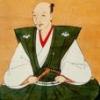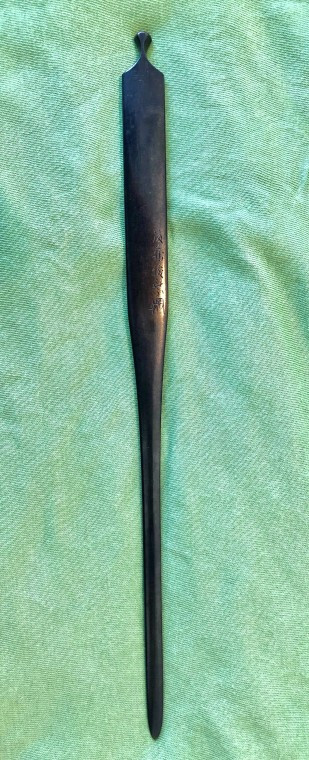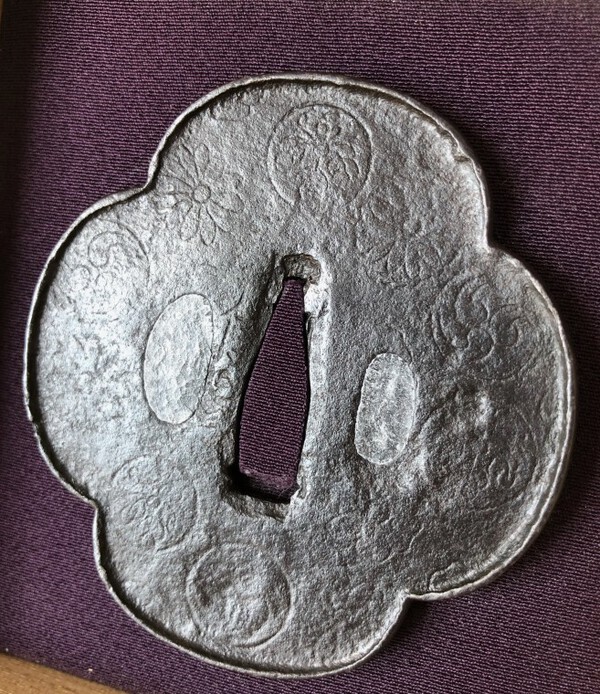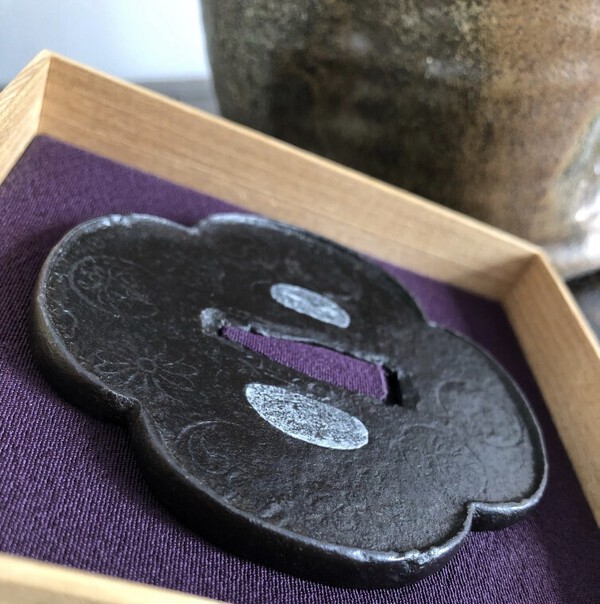-
Posts
950 -
Joined
-
Last visited
-
Days Won
4
Content Type
Profiles
Forums
Events
Store
Downloads
Gallery
Everything posted by Steve Waszak
-
Wish I had one for everyone!
-
PM sent.
-
-
-
-
Goto Shunjo (1740-1822) was the grandfather of the great Goto Ichijo. The lineage here begins with Goto Kenjo (1586-1663), the seventh mainline Shirobei master. This kogai is excellent in both its execution and condition, featuring fine, even nanako as a background for the long-earred rabbit motif. The eyes of the rabbit are inlaid in gold. There is very little wear evident. The overall presentation of this kogai is very pleasing, with the smooth contours of the form of the rabbit juxtaposed against the crisp, clear nanako work. The kogai is signed on the reverse, Goto Shunjo. Measurements are 21.1cm x 1.2cm. Circa late-18th century. Boxed. A very fine shakudo kogai. $850.00, plus shipping. CORRECTION! A fellow member with much more knowledge than I on the Goto lineage of fittings makers has corrected me with regards to the identity of the Goto smith who made this kogai. It seems there were two Goto Shunjo smiths, one who was also known as Mitsunaga (1634-1712). This is the actual maker of this kogai. He dates to roughly a century earlier than the later Goto Shunjo (Mitsukazu) who was Goto Ichijo's grandfather. So, the proper dating of this kogai is actually likely to be the latter part of the 17th century. Below please find an image of the chart detailing the lineage. Sorry for the error! And many thanks to the member who PM'd me with the correction! Steve
-

Translation assistance, please :)
Steve Waszak replied to Steve Waszak's topic in Translation Assistance
Thanks so much, Matt. Much appreciated! -
Would anyone be able to read/translate this signature for me? Many thanks in advance... Cheers, Steve
-

Darcy's current tosogu listings
Steve Waszak replied to Brian's topic in Auctions and Online Sales or Sellers
-

Darcy's current tosogu listings
Steve Waszak replied to Brian's topic in Auctions and Online Sales or Sellers
Darcy's offerings are truly top-shelf. Thanks, Brian, for starting this thread. You're right, we do need to expose ourselves to high(est)-level items, whether in blades or tosogu, lest we begin to see the merely good as great, and the "merely" great as magnificent. In fittings, Darcy does favor the soft-metal side of things; however, he occasionally throws a bone to some of the early iron works. Fortunately for me. https://yuhindo.com/nobuie/ -
Sanmai on that, Curran? Ah, yes, well that right there certainly changes things. Thanks for the good insight and education. Cheers, Steve
-
Hi Bob, Yes, that's a nice one on Fred's site. In my somewhat limited experience with Ohno, that's about as large as I see them (and this one is larger than most). Shoami does seem to be the "grab bag" of tsuba attribution all right... That vertical stanchion would appear to be deliberately askew, which in my view adds much interest and more liveliness to the guard, not just for its resulting expression, but also in raising questions of the maker's intent. A good, solid tsuba, Bob. Well done.
-
Hi Bob, Nice guard. Due to its size alone I would tend to doubt Ohno. I rarely see Ohno work larger than 7.5cm, and in fact, 7cm is more in keeping with what I usually see in tsuba attributed to Ohno. This piece reminds me of the very first tsuba I ever bought, roughly a million years ago now (in tsuba collecting years), pictured below (photos taken from Jinsoo Kim's site), and attributed to Shoami. There are differences, of course, in sugata and hitsuana shape, and the shape of the seppa-dai is markedly different, but it wouldn't surprise me if they were from the same "school." The size of this one is 8.8cm x 5mm. I think guards of this size are rather rare in the Edo Period, so I would place both of these in the pre-Edo years (16th century). My best guess, anyway. Cheers, Steve
-
Hi Mikolaj, This tsuba ,in my view, is probably a later "homage" piece. The mei is certainly not that of any of the Momoyama Yamakichibei men, and it does not strike me as likely to have been done by either of the Norisuke smiths: not only is the stroke production quite different from the way the Norisuke inscribe the "Yamakichibei" characters when they make homage pieces, but also, the Norisuke smiths would usually (or always) also sign their Yamakichibei utsushi with their own names, too, often in so doing indicating the utsushi intent behind the making of the work (thanks to Curran for pointing this out to me 🙂). Further, the workmanship (metal treatment) does not align very tightly with the Norisuke Yamakichi guards I have seen. At the same time, the edges of the sukashi appear too crisp/sharp for genuine early Yamakichibei work. What's interesting about this guard, and one of the indicators that it is probably a later copy/homage work, is that there appears to be an effort to emulate the mei of the Shodai (not Yamasaka Kichibei or "O-Shodai, but the "Meijin Shodai"), yet the actual design and features are decidedly Nidai. The Shodai Yamakichibei did not use uchikaeshi-mimi or sukinokoshi-mimi, so the fact that we see that feature on a tsuba with a Meijin-Shodai-esque signature creates a contradiction. At the same time, there are other curious details. The width of the nakago-ana is rather noteworthy -- it seems quite wide, and, given the size of the tsuba overall, would seem to have been intended to accommodate a pretty substantial blade. The sekigane hint at the the possibility of the tsuba having been mounted at least twice. Both of these details may point to earlier production, but of course, we cannot reach any definite conclusions based on this. It looks to be a pretty well done utsushi, Mikolaj. Here is the tsuba I have that is very similar to it -- a Nidai Yamakichibei piece. Cheers, Steve
-
Not that I know of, no. I certainly haven't heard of any. I'm not sure that such pattern books existed for tsubako in the Momoyama and earliest-Edo years. I'd be interested to hear of any, though.
-
David, Not sure about Robert Buroway's comment at the time he made it, but presently, that comment certainly would not be accurate. As to the tsuba you posted, I'm not sure that it would qualify even as revivalist. Nothing about it suggest even a rudimentary understanding of Yamakichibei workmanship or sensibilities (the amida yasuri is far from how the Yamakichibei smiths [notably, the Nidai] did it). Take the inscription away, and who would look at this piece and say, "Yamakichibei"? This strikes me as perhaps a post-Edo, or even post-Meiji item. I can't even really call it a copy, since it has no Yamakichi features at all. Even the motif is not one they used...
-
Hi Curran, Oh, sorry: I didn't mean to suggest I was asking that question of you, personally. I was just throwing it out there as a "maybe???" I would agree with you, too, on the impression the rubbings section of the book leaves. Things are murky there indeed, but a big part of that is that my Japanese-reading skills, especially of such "scrawled" writing, are mediocre at best. John, yes, that is a good point. If the same person or group were making copies of different smiths' works, one might expect similarities in fundamental workmanship (plate construction, etc...) regardless of the artist being copied, and that this would likely differ from that of those original early smiths. I do wonder how often the 19th-century forgers had access to the genuine works of the smiths whose work they copied. It seems to me that, given the status of those who are mostly likely to have been in possession of Nobuiye, Kaneie, and Yamakichibei guards, there would have been something of a lack of opportunity for unofficial copying or utsushi making. How often would tsuba of that level have been available "on the street" to acquire or access? But for artists like the Norisuke, who enjoyed official status being employed by the Owari Tokugawa, that access would likely have been greater, perhaps even much greater. To me, this only lends credence to what Curran says about the relative improbability that the Norisuke made outright forgeries, that is, making tsuba carrying only a "Yamakichibei" or "Nobuiye" inscription without also including the Norisuke mei.
-
That would be my thinking, probably, yes. I pretty strongly doubt that the tsuba you posted with have anything to do with the early Yamakichibei group. The revivalist spirit seems to have been ascendant in 19th-century Japan, perhaps especially in the Bakumatsu Period and a decade or two before that. I think it's quite possible, in fact, that some of the Yamakichibei and Nobuiye copies/forgeries we see in this time may have been inspired by the Norisuke utsushi of those smiths' genuine works, as much as by the works themselves. Given the high official status of the Norisuke tsubako, one might imagine that their making quality utsushi of the tsuba of illustrious early artists could have generated a significant interest in such pieces, which may have spawned something of a "cottage industry" in creating "unofficial homages" to those artists' works. Whether those making these copies made them as one-off pieces or in a sustained effort to make many of them and keep a business going I can't say for sure, but I suppose it's likely that both occurred. Steve
-
Hi David, I'm afraid I don't have all of those catalogues. I do have catalogue #6, and tsuba #6 in it is described as a typical Norisuke II work. The photo is small and details are hard to see, but the inscription on it does seem to be similar to those I provide images of above. However, with only this one poor photo in the catalogue to refer to, I would refrain from drawing any confident conclusions... Since I don't have any other of the Haynes catalogues besides #s 6 and 7, I can't comment on the other examples you speak of. I would agree with Curran, though, as I said, that many of the later Yamakichibei copies, carrying only the "Yamakichibei" inscription, and ascribed to one of the Norisuke smiths, are likely to have been made by others, and not the Norisuke, either for reasons of (a lack of) quality, or because of the political circumstances Curran notes, or both. I do not believe there was a true "later" Yamakichibei workshop. By this I mean that I believe that the original atelier died out in the early-Edo Period, and that later, unrelated smiths took up the "trade name" and used it to market their wares, beginning with "Sakura Yamakichibei," who is (erroneously, I believe) referred to as Sandai Yamakichibei. I'm not sure if you've seen the article I did on this group of smiths; if not, it is available in the downloads section here. 🙂 Cheers, Steve
-
I would agree: given the fact that the Norisuke tsubako were retained by the Tokugawa, it certainly seems unlikely that they would be making "unauthorized" outright forgeries of Yamakichibei (or other signed) tsuba. As you say, Curran, it is possible that the Tokugawa may, on occasion, have directed them to make such a copy, but the frequency of such an event would have been, I should think, very low. And so, I would agree further that the tendency to "default" to Norisuke-made forgeries for well-made copies of Yamakichibei work is misguided. It is clear enough that they did make utsushi of Yamakichibei works and those of other big-name makers, but as you say, Curran, these would very likely have been signed by them in addition to carrying any "Yamakichibei" inscription. All of the above makes very good sense to me. What I am then a bit perplexed by are some of the images from the book in questions, which depict a nearly identical rendering of the Yamakichibei name, and which closely echo the inscription on the actual tsuba whose photos I posted above (see photos below). In these images from the book, there are details especially in the way the "KIchi" and "Bei" ji are done which are not only fairly uniform from tsuba to tsuba, but which are also strong departures from the way these characters are rendered by the actual Yamakichibei smith(s). So, to my eye, they cannot be depicting genuine Yamakichibei guards, yet they also do not depict a Norisuke mei along with the "Yamakichibei" inscription. I suspect that what we might be seeing here, therefore, are simply drawings (not rubbings) of designs that the Norisuke smiths were looking to work with, rather than images of tsuba they already had made. Once the tsuba were actually made, then (probably) they would include their own mei along with the "Yamakichibei" inscription. Just sort of thinking out loud here... 🙂 As I say, though, the particular way of drawing these inscriptions in the images from the book very closely echo the inscription on the actual tsuba I posted photos of earlier (posted again below). The "Yama" ji is a little different, since the initial stroke is higher in the inscription on the tsuba than is depicted in the inscriptions in the book images, but otherwise, the "Yama" ji is quite similar, and the "Kichi" and "Bei" ji are as well. Again, all of the renderings of these characters from the images in the book are strong departures from the mei on actual Yamakichibei sword guards in key ways, The last two photos below are of the classic, Juyo tsuba made by (Meijin) Shodai Yamakichibei, and next to it a rubbing taken from the Norisuke book. Since this is a rubbing, and not a drawing, IF this is a Norisuke utsushi, we would expect to see a Norisuke mei (and/or other inscription content) along with the "Yamakichibei" inscription on the seppa-dai , according to what we agree is the likely practice of how the Norisuke would have worked (of course, we cannot see the ura on this piece, and I am unable to make out what the caption is saying below it, so perhaps there is such content on the other side of the tsuba). The details of the inscription on this tsuba rubbing are wrong in all three characters for the actual signature of a Meijin Shodai guard, so this is certainly not a depiction of his work. The rendering of the bird sukashi, too, is different (though an artist can certainly alter the way he presents the sukashi motif on a tsuba, of course). So here we have a rubbing of an existing tsuba which does not carry the mei of the Meijin Shodai (or that of the other four early Yamakichibei smiths) and yet also does not present with a Norisuke mei or other content indicating a "formal" utsushi. Might this be one of the "special order forgeries" that would be the exception, rather than the rule? David notes that this subject needs a lot more investigation, and I would certainly concur with that. 🙂 Cheers, Steve
-
Hi David, Thanks for that. I just looked, and the mei is quite degraded. What's left, though, clearly indicates (to me) that this is not a true Yamakichibei piece, and, following Curran's lead, I would say it is not a Norisuke work, either. I am not a Norisuke expert, certainly, but there do seem to be certain characteristics to a Norisuke inscription of the Yamakichibei name that are fairly steady. As can be seen in the photos I posted, plus in those pages in the Futagoyama Norisuke Ko that I referenced, it does seem that, some/much of the time, anyway, that far-right (third) stroke of the Yama character is missing. The reason for this may be (partly) due to the fact that on genuine early Yamakichibei work, that same stroke is "compromised" by the adjustments made to the nakago-ana in that area. But it is all three characters of the Yamakichibei inscription on Norisuke works that have tell-tale signs of the Norisuke way of rendering this signature, not just the Yama-ji. Cheers, Steve
-
Hi David, Would you by any chance have other photos of this guard, especially of the mei? I am reasonably sure that this is not the work of any of the Yamakichibei smiths nor of either of the Norisuke men. It would be helpful to be able to see more of the mei, though... 🙂 One curious aspect of the Futagoyama Norisuke Ko publication is that the photos of actual tsuba made by the Norisuke smiths as utsushi of Yamakichibei works show only one piece -- a Shodai Norisuke work on page 2 -- that includes a "Yamakichibei" inscription (on the ura, along with the Norisuke mei). The other photos of Yamakichibei utsushi (the actual tsuba) include the Norisuke mei, but not any "Yamakichibei" inscription. However, the section of the book that focuses on what I believe are rubbings of Norisuke designs shows quite a few Yamakichibei utsushi which are depicted to be carrying "Yamakichibei" inscriptions, but do not illustrate a Norisuke mei along with those inscriptions (see pages 56, 58, 71, and 76). Unfortunately, among the quality of the reproduction of these rubbings, the cursory style of the writing forming the captions for these rubbing illustrations, and my own limited ability in Japanese, I can't make out all of what these captions say. *It would be good, as you imply, David, to have a translation of this book. 🙂 Included here is an example of what I believe to be a Norisuke utsushi of a Yamakichibei tsuba. If you examine the mei on this piece, and compare it to those on the pieces illustrated in the rubbings on the pages I mention above, you'll see a lot of similarities in the way the respective mei are rendered, I think. Cheers, Steve
-
Hi Jean, No problem to share what we discussed, if you like. Cheers, Steve
-
First, a thank you to Barry for all the assistance (and for the encouragement) in getting the article put together. Much appreciated, Barry! Happy to help anyone with an interest in this particular area of tsuba appreciation and scholarship, to the degree that I can. I just want to emphasize, too, that the theory I put forth in the article was (and remains) the best understanding I have of the Yamakichibei group, but that my views could change as new information comes to light. Cheers, Steve
-
Okay, I've sent Brian the PDF. Fingers crossed that the formatting holds together. Cheers, all Steve





























